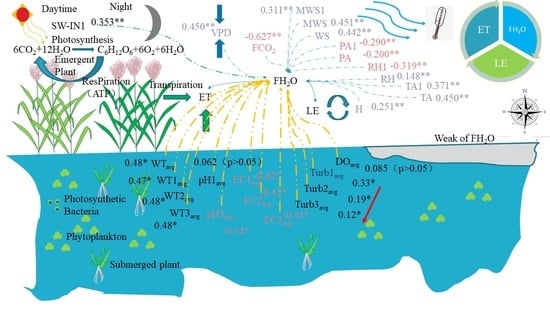Impact Analysis of H2O Fluxes and High-Frequency Meteorology–Water Quality: Multivariate Constrained Evaporation Modelling in Lake Wuliangsuhai, China
Abstract
1. Introduction
2. Materials and Methods
2.1. Study Area
2.2. Sample Collection and Determination
2.2.1. Observation of Vorticity Flux
2.2.2. High-Frequency Meteorological–Water Quality Monitoring
2.2.3. China’s General Water Surface Evaporation Formula C
2.3. Data Processing
3. Results
3.1. Variation Characteristics of FH2O (ET) and Environmental Factors Were Analyzed
3.1.1. High-Frequency Water Quality Determination Factor
3.1.2. Meteorological Factors
3.2. Influence of FH2O on Different Time Scales
3.2.1. Correlation between Overall Scale FH2O and Meteorological Factors
3.2.2. Correlation between FH2O and Environmental Factors in the Non-Freezing Period to Early Freezing Period
3.3. Evaporation Model from the Non-Freezing Period to the Early Freezing Period
3.3.1. FH2O Principal Component Regression Equation Model
3.3.2. FH2O Regression Model Validation
4. Discussion
4.1. Lake Stratification and Water Quality Impact
4.1.1. No Stratified Change Water Quality Index
4.1.2. With Stratified Changes in Water Quality Indicators
4.2. Diurnal Variation of ET in the Non-Freezing Period to Early Freezing Period
4.3. Comparison of the Model with Evaporation Dish Conversion and Regional Empirical C Formula Method
4.3.1. Comparison of Model and Evaporation Dish Conversion
- (1)
- The first reason is that the thermal conditions and energy dissipation significantly affect the accuracy of the measurements due to the:
- (i)
- The ability of a lake to absorb solar radiation is greater due to its larger albedo, which means that the energy is quickly dissipated and does not directly contribute to evaporation. Additionally, the high specific heat capacity of natural water bodies like lakes requires more heat to evaporate the same amount of water, resulting in less evaporation under the same thermal radiation.
- (ii)
- The land surface possesses a greater expanse than both the temperature and the diurnal temperature fluctuation of the lake. Additionally, it presents a more favorable condition for water vaporization.
- (iii)
- The transverse heat exchange within the evaporator enhances the evaporation rate.
- (2)
- The second reason is related to the specific conditions of the lake, such as:
- (i)
- Wuliangsuhai is abundant in emergent plants such as reeds. These plants can effectively block sunlight, thereby reducing evaporation from the water surface. In addition, they can condense the water vapor under their leaves to prevent evaporation.
- (ii)
- The salinity of lakes is higher than that of pans, and high salinity can reduce water activity, effectively inhibiting evaporation [44].
- (3)
- The third reason pertains to the wind power and steam conditions such as:
- (i)
- The relative humidity of the lake is higher than that of the pan, whereas the VPD is lower.
- (ii)
4.3.2. Comparison of the Model with the Regional Empirical C Formula Method
5. Conclusions
Supplementary Materials
Author Contributions
Funding
Data Availability Statement
Conflicts of Interest
References
- Jing, S.; Xiao, W.; Wang, J. Evaporation variability and its control factors of Lake Taihu from 1958 to 2017. J. Lake Sci. 2022, 34, 1697–1711. [Google Scholar] [CrossRef]
- Oki, T.; Kanae, S. Global hydrological cycles and world water resources. Science 2006, 313, 1068–1072. [Google Scholar] [CrossRef]
- Liu, Y.; Qiu, G.; Zhang, H.; Yang, Y.; Zhang, Y.; Wang, Q.; Zhao, W.; Jia, L.; Ji, X.; Xiong, Y.; et al. Shifting from homogeneous to heterogeneous surfaces in estimating terrestrial evapotranspiration: Review and perspectives. Sci. China Earth Sci. 2022, 65, 197–214. [Google Scholar] [CrossRef]
- Liu, H.; Zhang, Y.; Liu, S.; Jiang, H.; Sheng, L.; Williams, Q.L. Eddy covariance measurements of surface energy budget and evaporation in a cool season over southern open water in Mississippi. J. Geophys. Res. Atmos. 2009, 114. [Google Scholar] [CrossRef]
- Walter, K.M.; Zimov, S.A.; Chanton, J.P.; Verbyla, D.; Chapin, F.S., III. Methane bubbling from Siberian thaw lakes as a positive feedback to climate warming. Nature 2006, 443, 71–75. [Google Scholar] [CrossRef] [PubMed]
- Long, Z.; Perrie, W.; Gyakum, J.; Caya, D.; Laprise, R. Northern lake impacts on local seasonal climate. J. Hydrometeorol. 2007, 8, 881–896. [Google Scholar] [CrossRef]
- Yao, X.; Yang, K.; Zhou, X.; Wang, Y.; Lazhu Chen, Y.; Lu, H. Surface friction contrast between water body and land enhances precipitation downwind of a large lake in Tibet. Clim. Dyn. 2021, 56, 2113–2126. [Google Scholar] [CrossRef]
- Xu, L.; Liu, H.; Du, Q.; Wang, L.; Yang, L.; Sun, J. Differences of atmospheric boundary layer characteristics between pre-monsoon and monsoon period over the Erhai Lake. Theor. Appl. Climatol. 2019, 135, 305. [Google Scholar] [CrossRef]
- Bai, P.; Wang, Y. The Importance of Heat Storage for Estimating Lake Evaporation on Different Time Scales: Insights from a Large Shallow Subtropical Lake. Water Resour. Res. 2023, 59, e2023WR035123. [Google Scholar] [CrossRef]
- Zhao, G.; Li, Y.; Zhou, L.; Gao, H. Evaporative water loss of 1.42 million global lakes. Nat. Commun. 2022, 13, 3686. [Google Scholar] [CrossRef]
- Ritchie, H.; Roser, M. Water Use and Stress, Our World in Data. 2017. Available online: https://ourworldindata.org/water-use-stress (accessed on 6 November 2023).
- Zhao, G.; Gao, H.; Cai, X. Estimating lake temperature profile and evaporation losses by leveraging MODIS LST data. Remote Sens. Environ. 2020, 251, 112104. [Google Scholar] [CrossRef]
- Ito, Y.; Momii, K. Potential effects of climate changes on evaporation from a temperate deep lake. J. Hydrol. Reg. Stud. 2021, 35, 100816. [Google Scholar] [CrossRef]
- Pérez, A.; Lagos, O.; Lillo-Saavedra, M.; Souto, C.; Paredes, J.; Arumí, J.L. Mountain lake evaporation: A comparative study between hourly estimations models and in situ measurements. Water 2020, 12, 2648. [Google Scholar] [CrossRef]
- Xu, W.; Wang, X.; Zhang, J. Research on in-situ test of lake evaporation in the Ordos Plateau. Hydrogeol. Eng. Geol. 2019, 46, 1000–3665. [Google Scholar] [CrossRef]
- El-Mahdy ME, S.; El-Abd, W.A.; Morsi, F.I. Forecasting lake evaporation under a changing climate with an integrated artificial neural network model: A case study Lake Nasser, Egypt. J. Afr. Earth Sci. 2021, 179, 104191. [Google Scholar] [CrossRef]
- Zhou, W.; Wang, L.; Li, D.; Leung, L.R. Spatial Pattern of Lake Evaporation Increases under Global Warming Linked to Regional Hydroclimate Change. Commun. Earth Environ. 2021, 2, 255. [Google Scholar] [CrossRef]
- Wang, W.; Lee, X.; Xiao, W.; Liu, S.; Schultz, N.; Wang, Y.; Zhang, M.; Zhao, L. Global lake evaporation accelerated by changes in surface energy allocation in a warmer climate. Nat. Geosci. 2018, 11, 410–414. [Google Scholar] [CrossRef]
- Wang, B.; Ma, Y.; Su, Z.; Wang, Y.; Ma, W. Quantifying the evaporation amounts of 75 high-elevation large dimictic lakes on the Tibetan Plateau. Sci. Adv. 2020, 6, eaay8558. [Google Scholar] [CrossRef]
- Cui, Y.; Liu, Y. Advances in observation and calculation of lake evaporation. J. Lake Sci. 2023, 35, 1501–1515. [Google Scholar] [CrossRef]
- Phillips, R.C.; Saylor, J.R.; Kaye, N.B.; Gibert, J.M. A multi-lake study of seasonal variation in lake surface evaporation using MODIS satellite-derived surface temperature. Limnology 2016, 17, 273–289. [Google Scholar] [CrossRef]
- Momii, K.; Ito, Y. Heat budget estimates for lake Ikeda, Japan. J. Hydrol. 2008, 361, 362–370. [Google Scholar] [CrossRef]
- Li, X.Y.; Ma, Y.J.; Huang, Y.M.; Hu, X.; Wu, X.C.; Wang, P.; Li, G.Y.; Zhang, S.Y.; Wu, H.W.; Jiang, Z.Y.; et al. Evaporation and surface energy budget over the largest high-altitude saline lake on the Qinghai-Tibet Plateau. J. Geophys. Res. Atmos. 2016, 121, 10–470. [Google Scholar] [CrossRef]
- Assouline, S.; Tyler, S.W.; Tanny, J.; Cohen, S.; Bou-Zeid, E.; Parlange, M.B.; Katul, G.G. Evaporation from three water bodies of different sizes and climates: Measurements and scaling analysis. Adv. Water Resour. 2008, 31, 160–172. [Google Scholar] [CrossRef]
- Chapin, F.S., III; McGuire, A.D.; Randerson, J.; Pielke, R.; Baldocchi, D.; Hobbie, S.E.; Roulet, N.; Eugster, W.; Kasischke, E.; Rastetter, E.B.; et al. Arctic and boreal ecosystems of western North America as components of the climate system. Glob. Change Biol. 2000, 6, 211–223. [Google Scholar] [CrossRef]
- Webb, E.K.; Pearman, G.I.; Leuning, R. Correction of flux measurements for density effects due to heat and water vapour transfer. Q. J. R. Meteorol. Soc. 1980, 106, 85–100. [Google Scholar] [CrossRef]
- McDermitt, D.; Burba, G.; Xu, L.; Anderson, T.; Komissarov, A.; Riensche, B.; Schedlbauer, J.; Starr, G.; Zona, D.; Oechel, W.; et al. A new low-power, open-path instrument for measuring methane flux by eddy covariance. Appl. Phys. B 2011, 102, 391–405. [Google Scholar] [CrossRef]
- Foken, T.; Göockede, M.; Mauder, M.; Mahrt, L.; Amiro, B.; Munger, W. Post-field data quality control. In Handbook of Micrometeorology: A Guide for Surface Flux Measurement and Analysis; Springer: Dordrecht, The Netherlands, 2004; pp. 181–208. [Google Scholar]
- Massman, W.J.; Lee, X. Eddy covariance flux corrections and uncertainties in long-term studies of carbon and energy exchanges. Agric. For. Meteorol. 2002, 113, 121–144. [Google Scholar] [CrossRef]
- Leuning, R.A.Y.; Judd, M.J. The relative merits of open-and closed-path analysers for measurement of eddy fluxes. Glob. Change Biol. 1996, 2, 241–253. [Google Scholar] [CrossRef]
- Finch, J.; Hall, R. Estimation of Open Water Evaporation: A Review of Methods; Environment Agency: Bristol, UK, 2001.
- Aydin, H.; Karakuş, H. Estimation of evaporation for Lake Van. Environ. Earth Sci. 2016, 75, 1275. [Google Scholar] [CrossRef]
- Antonopoulos, V.Z.; Gianniou, S.K.; Antonopoulos, A.V. Artificial neural networks and empirical equations to estimate daily evaporation: Application to lake Vegoritis, Greece. Hydrol. Sci. J. 2016, 61, 2590–2599. [Google Scholar] [CrossRef]
- Liu, H.; Zhang, Q.; Dowler, G. Environmental controls on the surface energy budget over a large southern inland water in the United States: An analysis of one-year eddy covariance flux data. J. Hydrometeorol. 2012, 13, 1893–1910. [Google Scholar] [CrossRef]
- Boehrer, B.; Schultze, M. Stratification of lakes. Rev. Geophys. 2006, 46. [Google Scholar] [CrossRef]
- Wang, W.; Xiao, W.; Cao, C.; Gao, Z.; Hu, Z.; Liu, S.; Shen, S.; Wang, L.; Xiao, Q.; Xu, J.; et al. Temporal and spatial variations in radiation and energy balance across a large freshwater lake in China. J. Hydrol. 2014, 511, 811–824. [Google Scholar] [CrossRef]
- Xiao, K.; Griffis, T.J.; Baker, J.M.; Bolstad, P.V.; Erickson, M.D.; Lee, X.; Wood, J.D.; Hu, C.; Nieber, J.L.; Nieber, J.L. Evaporation from a temperate closed-basin lake and its impact on present, past, and future water level. J. Hydrol. 2018, 561, 59–75. [Google Scholar] [CrossRef]
- Nordbo, A.; Launiainen, S.; Mammarella, I.; Lepparanta, M.; Huotari, J.; Ojala, A.; Vesala, T. Long-term energy flux measurements and energy balance over a small boreal lake using eddycovariance technique. J. Geophys. Res. 2011, 116. [Google Scholar] [CrossRef]
- Li, Z.; Lyu, S.; Ao, Y.; Wen, L.; Zhao, L.; Wang, S. Long-term energy flux and radiation balance observations over Lake Ngoring, Tibetan Plateau. Atmos. Res. 2015, 155, 13–25. [Google Scholar] [CrossRef]
- Liang, G.; Lu, S.; Cai, M.J. Conversion coefficient and climate calculation of small evaporator in arid area. J. Yellow River Conserv. Tech. Inst. 2002, 3, 37–39. [Google Scholar] [CrossRef]
- Allen, R.G.; Tasumi, M. Evaporation from American Falls Reservoir in Idaho via a combination of Bowen ratio and eddy covariance. In Impacts of Global Climate Change; ASCE: Reston, VA, USA, 2005; pp. 1–17. [Google Scholar] [CrossRef]
- Zhao, X.; Li, M.; Wang, S.; Liu, Y. Comparison of actual water evaporation and pan evaporation in summer over the Lake Poyang, China. J. Lake Sci. 2015, 27, 343–351. [Google Scholar] [CrossRef]
- Grismer, M.E.; Orang, M.; Snyder, R.; Matyac, R. Pan evaporation to reference evapotranspiration conversion methods. J. Irrig. Drain. Eng. 2002, 128, 180–184. [Google Scholar] [CrossRef]
- Mor, Z.; Assouline, S.; Tanny, J.; Lensky, I.M.; Lensky, N.G. Effect of water surface salinity on evaporation: The case of a diluted buoyant plume over the Dead Sea. Water Resour. Res. 2018, 54, 1460–1475. [Google Scholar] [CrossRef]
- Blanken, P.D.; Rouse, W.R.; Culf, A.D.; Spence, C.; Boudreau, L.D.; Jasper, J.N.; Kochtubajda, B.; Schertzer, W.M.; Marsh, P.; Verseghy, D. Eddy covariance measurements of evaporation from Great Slave Lake, Northwest Territories, Canada. Water Resour. Res. 2000, 36, 1069–1077. [Google Scholar] [CrossRef]
- Martínez, J.M.M.; Alvarez, V.M.; González-Real, M.M.; Baille, A. A simulation model for predicting hourly pan evaporation from meteorological data. J. Hydrol. 2006, 318, 250–261. [Google Scholar] [CrossRef]
- Roderick, M.L.; Rotstayn, L.D.; Farquhar, G.D.; Hobbins, M.T. On the attribution of changing pan evaporation. Geophys. Res. Lett. 2007, 34, 17. [Google Scholar] [CrossRef]
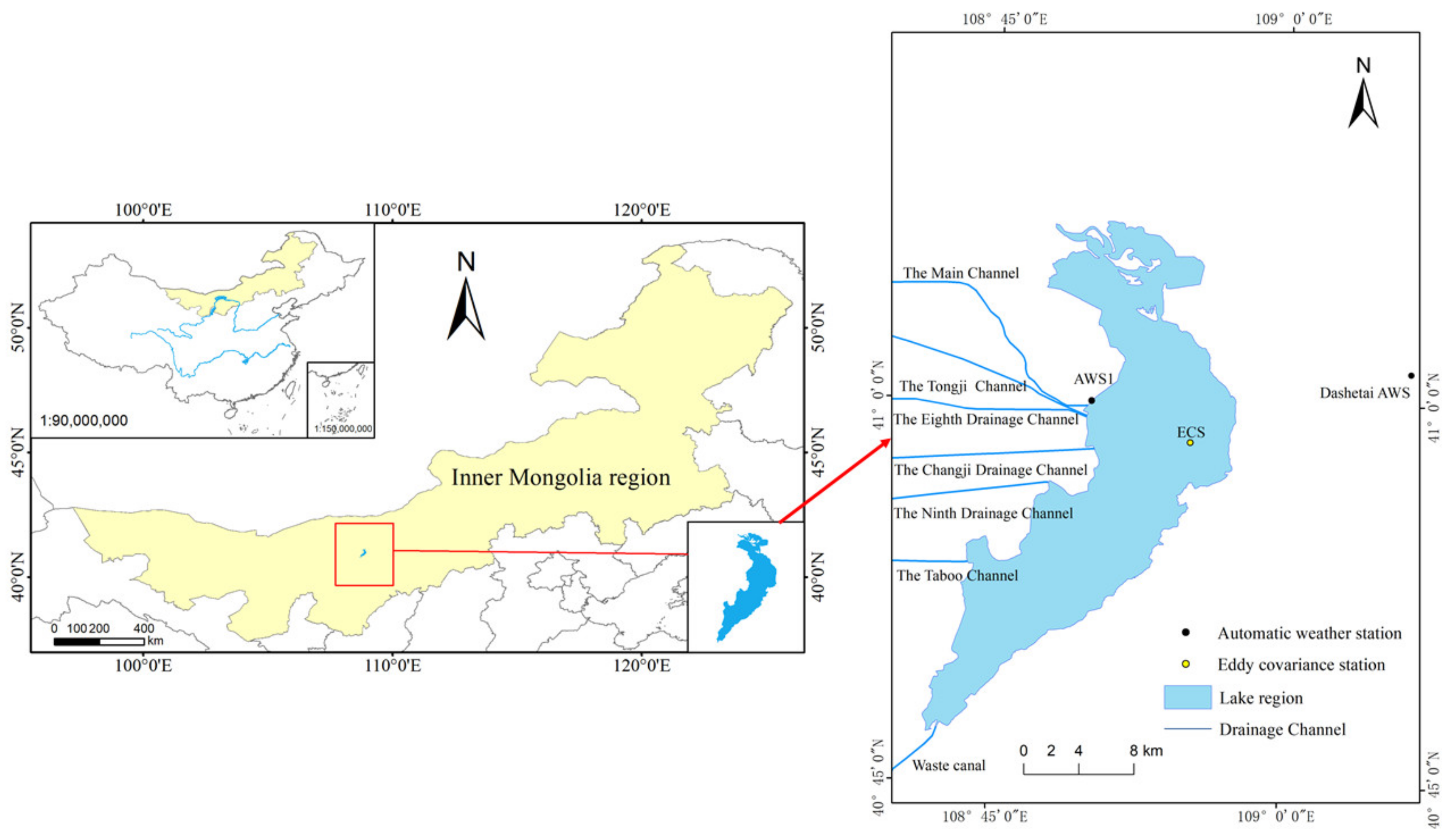
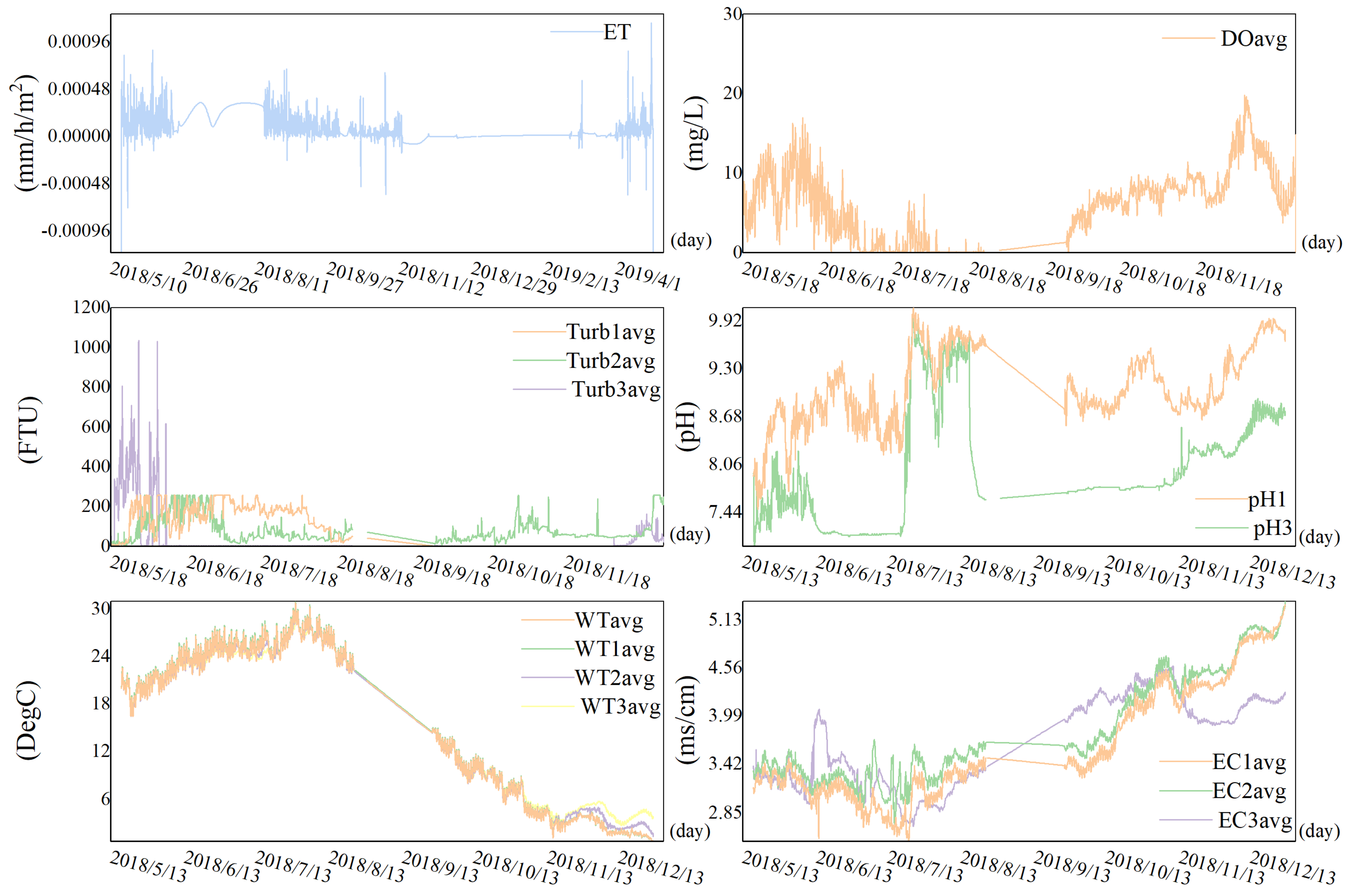

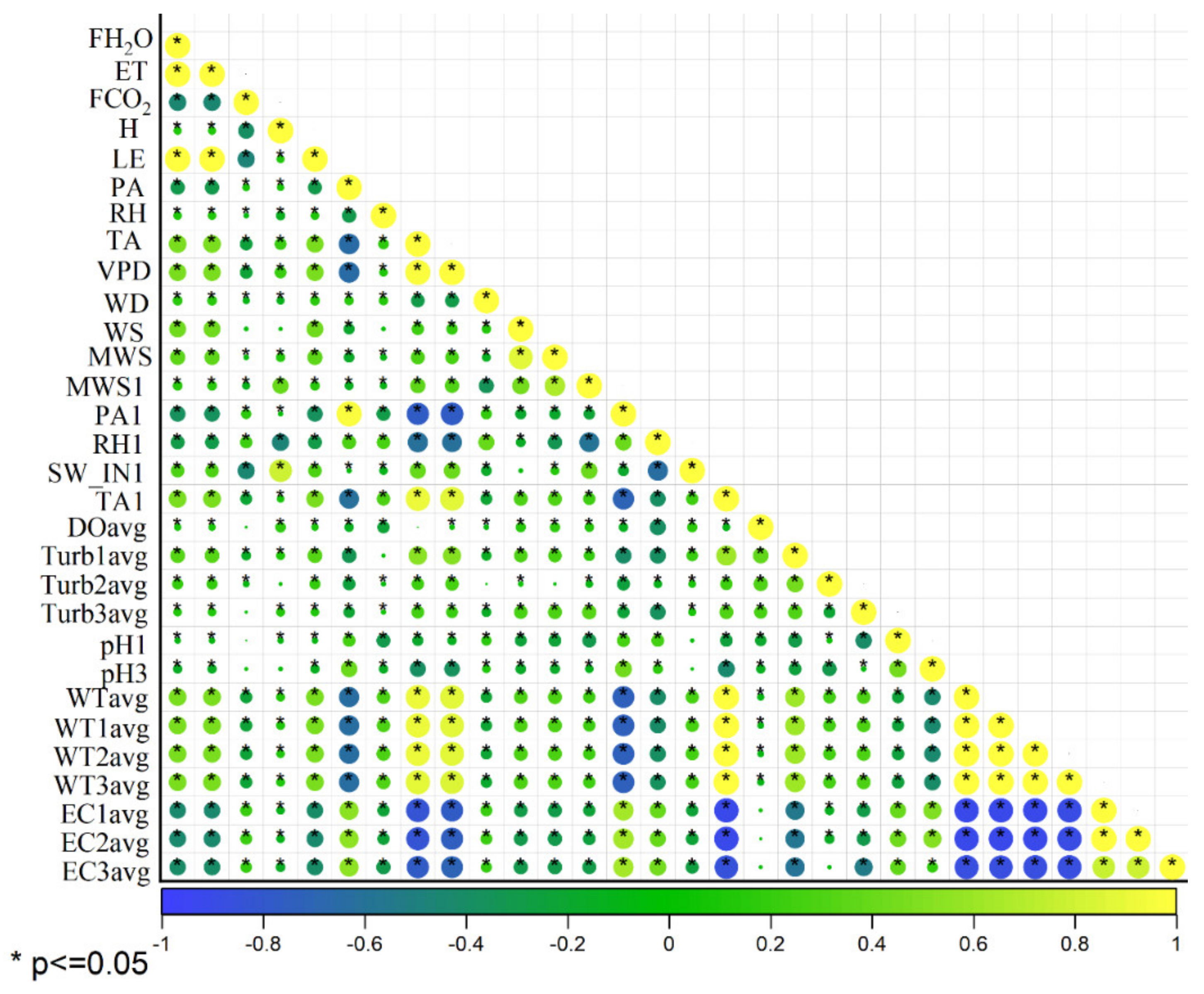
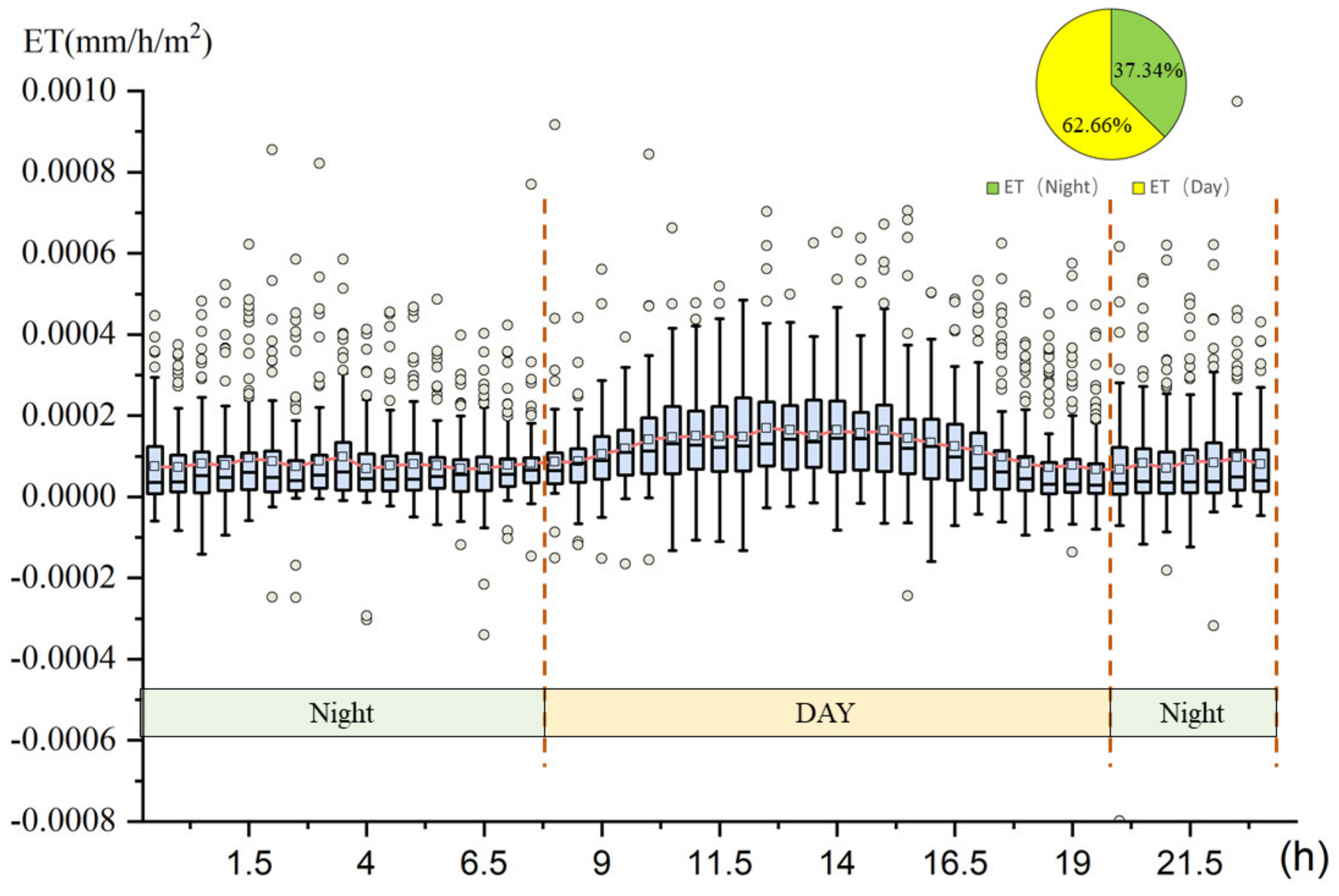


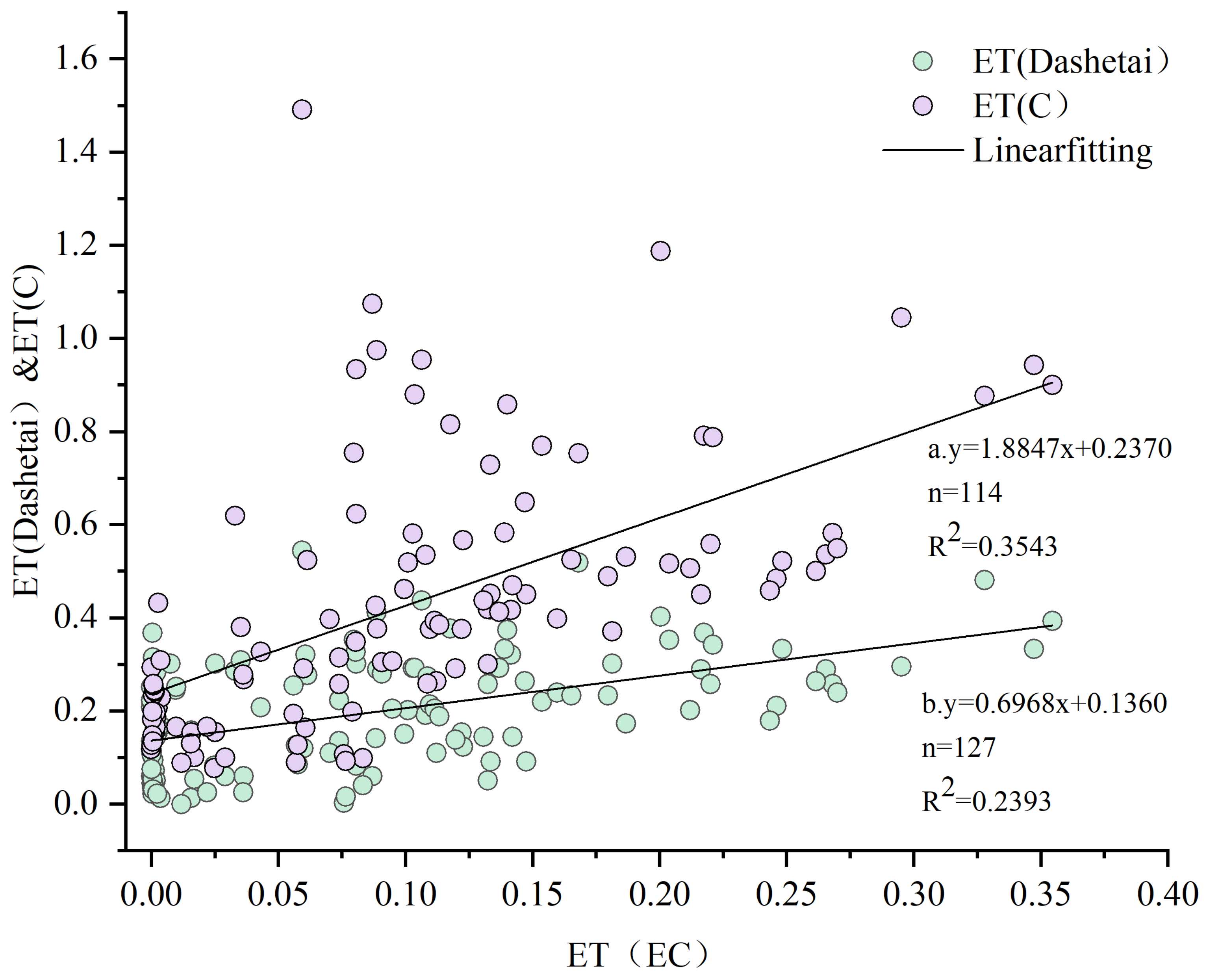
Disclaimer/Publisher’s Note: The statements, opinions and data contained in all publications are solely those of the individual author(s) and contributor(s) and not of MDPI and/or the editor(s). MDPI and/or the editor(s) disclaim responsibility for any injury to people or property resulting from any ideas, methods, instructions or products referred to in the content. |
© 2024 by the authors. Licensee MDPI, Basel, Switzerland. This article is an open access article distributed under the terms and conditions of the Creative Commons Attribution (CC BY) license (https://creativecommons.org/licenses/by/4.0/).
Share and Cite
Sun, Y.; Shi, X.; Zhao, S.; Li, G.; Sun, B.; Huotari, J. Impact Analysis of H2O Fluxes and High-Frequency Meteorology–Water Quality: Multivariate Constrained Evaporation Modelling in Lake Wuliangsuhai, China. Water 2024, 16, 578. https://doi.org/10.3390/w16040578
Sun Y, Shi X, Zhao S, Li G, Sun B, Huotari J. Impact Analysis of H2O Fluxes and High-Frequency Meteorology–Water Quality: Multivariate Constrained Evaporation Modelling in Lake Wuliangsuhai, China. Water. 2024; 16(4):578. https://doi.org/10.3390/w16040578
Chicago/Turabian StyleSun, Yue, Xiaohong Shi, Shengnan Zhao, Guohua Li, Biao Sun, and Jussi Huotari. 2024. "Impact Analysis of H2O Fluxes and High-Frequency Meteorology–Water Quality: Multivariate Constrained Evaporation Modelling in Lake Wuliangsuhai, China" Water 16, no. 4: 578. https://doi.org/10.3390/w16040578
APA StyleSun, Y., Shi, X., Zhao, S., Li, G., Sun, B., & Huotari, J. (2024). Impact Analysis of H2O Fluxes and High-Frequency Meteorology–Water Quality: Multivariate Constrained Evaporation Modelling in Lake Wuliangsuhai, China. Water, 16(4), 578. https://doi.org/10.3390/w16040578






